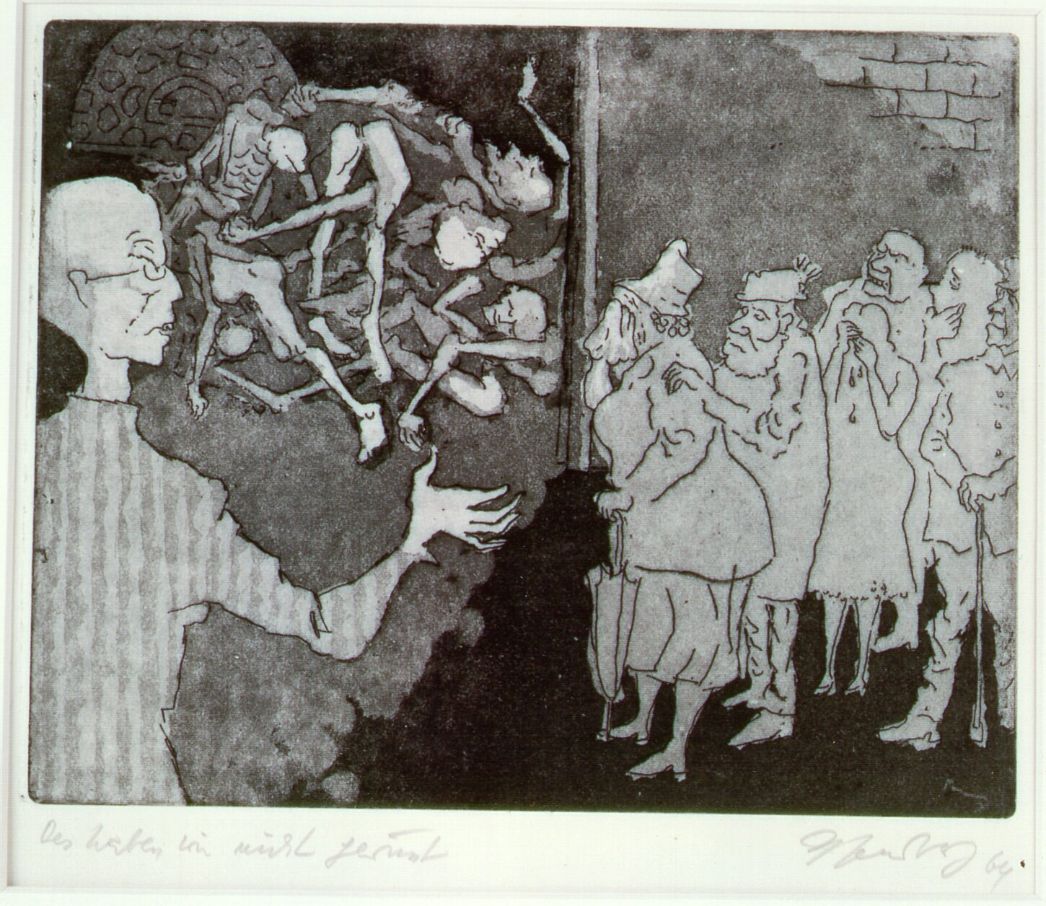
Buchenwald was the first American-liberated concentration camp in which the testimonies to the crimes had not been erased. On the contrary, the scenes of the mass overcrowded camp sinking into chaos and the heaps of corpses were still there for all to see. And these scenes were accordingly the focus of the American and Western European press coverage of the National Socialist concentration camps.
By order of the Americans, and under escort of U.S. military police, citizens of the City of Weimar had to tour the concentration camp on Ettersberg Mountain on 16 April 1945, five days after the liberation. Survivors guided the visitors around the camp and explained what had happened to them there. Photos showing their shocked reactions to the evidence of the harrowing events went around the world. The artistic memories of this occasion by survivors, on the other hand, are less well known.
In 1964, the graphic artist and caricaturist Herbert Sandberg, a political inmate of the Buchenwald concentration camp from 1938 to 1945, interpreted the scene pictorially. He depicted himself as an inmate alongside dead bodies in the courtyard of the crematorium (the door of a corpse incineration oven is discernible at the upper left). With outstretched hand, he motions to the visitors to face up to the evidence of the crimes—to step closer to the emaciated bodies. The well-fed, well-dressed citizens have been drawn with a sharp pen. Horror is written in their faces, but their words reveal how much they repress what has happened in their midst: “We didn’t know!”
This denial, a widespread phenomenon, is pointedly cited in the picture caption. The image is part of a series of seventy aquatint etchings in which Herbert Sandberg revisited scenes from his life. The nineteen sheets depicting Buchenwald form the core of the series, which was executed between 1958 and 1965 and published as a book (Der Weg) in 1966.
Biography
The graphic artist and caricaturist Herbert Sandberg was born in Posen on 18 April 1908, the son of a Jewish merchants’ family. In 1925 he attended the school of arts and crafts and the academy in Wroclaw for a brief time. He left his parents’ home at an early age and began drawing for newspapers and magazines. He went to Berlin in 1928, became a member of the Association of Revolutionary Visual Artists of Germany, and joined the German Communist Party (KPD). After 1933 he become involved in the resistance against the Nazi dictatorship. He was arrested in 1934 and incarcerated in the Brandenburg-Görden prison; in July 1938 he was committed to the Buchenwald concentration camp. There he worked as a mason and survived thanks to the solidarity of his fellow inmates. In 1944 he used furnace soot and whiting to make sketches of his camp experiences. After the camp’s liberation on 11 April 1945, he published these sketches along with other drawings in the form of a block book (Eine Freundschaft, 30 woodcut sketches, 1949).
On 24 December 1945, eight months after his liberation from the camp, Sandberg and the writer Günther Weisenborn together founded the political-satirical magazine Ulenspiegel, which featured caricatures, cartoons, comics, and satires on current events. In keeping with his motto “I can only depict what I have experienced myself”, Sandberg’s intention was to mirror his own history in contemporary history as a kind of artistic commentator, using caricature as a means of emphasis. He drew for various newspapers and magazines and published several books. Herbert Sandberg died in Berlin on 18 March 1991.


